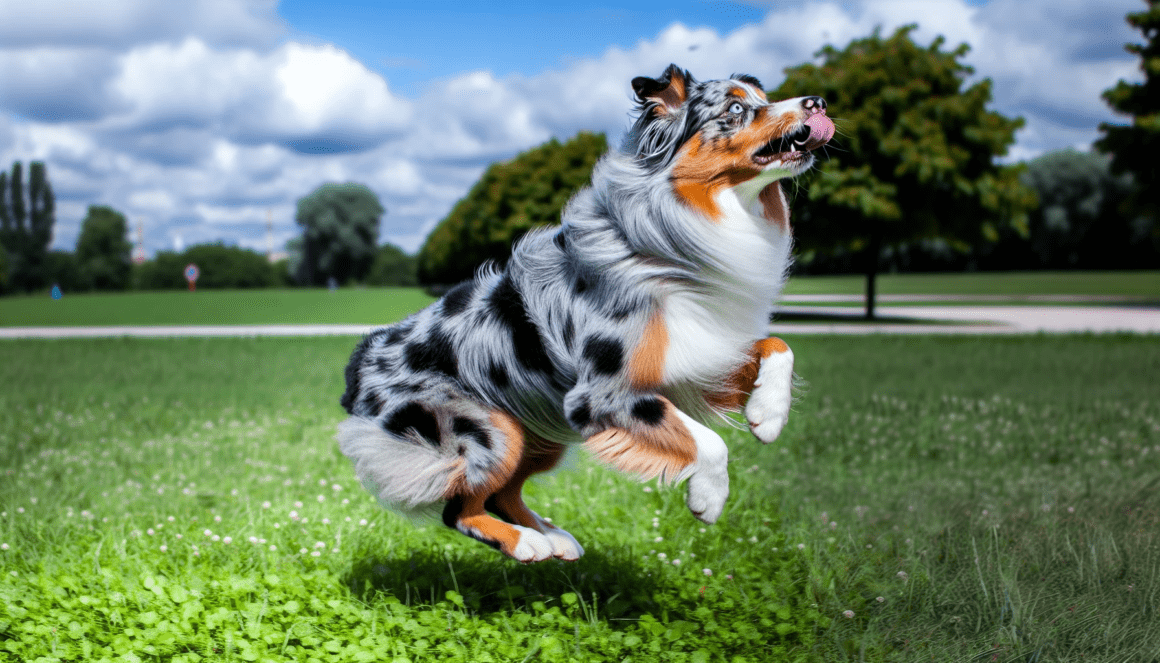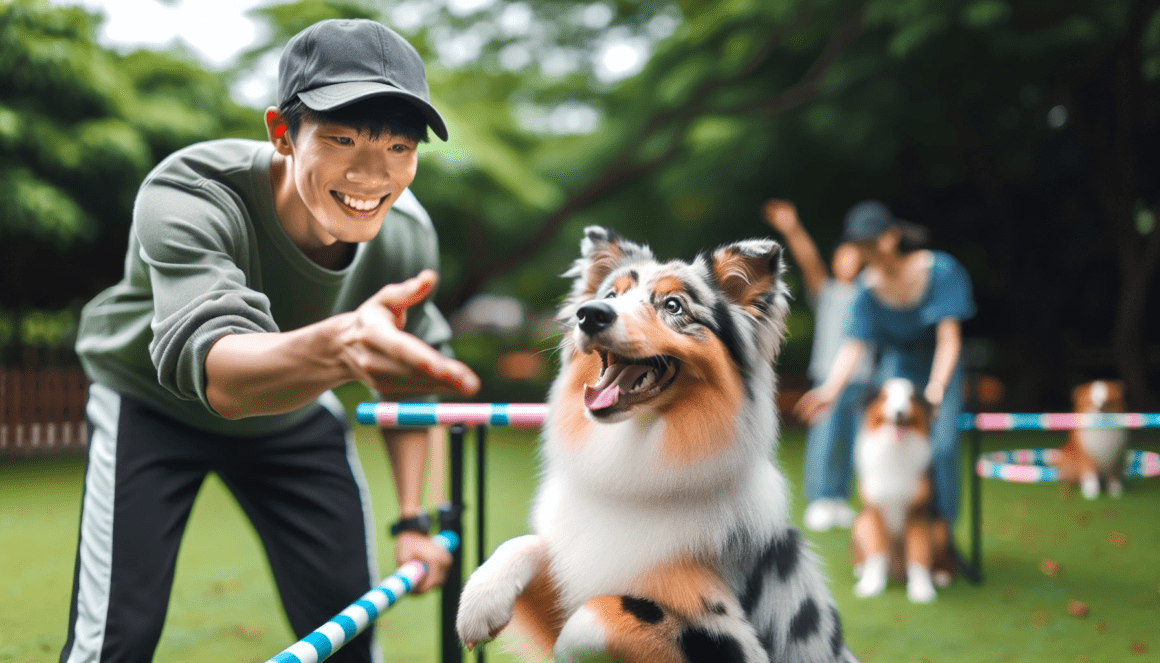Have you ever been captivated by the striking appearance and boundless energy of an Australian Shepherd? These intelligent and versatile dogs are more than just a pretty face. With their exceptional herding abilities, keen instincts, and loyal disposition, Australian Shepherds make wonderful companions and working dogs. This blog post will provide a comprehensive guide to understanding, caring for, and training your Australian Shepherd, ensuring a happy and fulfilling life together.
Whether you’re considering adding an Aussie to your family or already have one as a beloved companion, this guide will help you navigate their unique traits, exercise requirements, grooming needs, and more. So, let’s embark on this journey to better understand these amazing dogs and learn how to provide the best possible care for them.
Understanding the Australian Shepherd
Despite their name, Australian Shepherds actually originated in the United States, with their ancestors brought over from Europe via Australia in the 1840s. This Australian Shepherd history is deeply rooted in their exceptional herding abilities, as they were initially developed to assist ranchers and farmers in the western United States with their livestock management needs. Their hardworking nature, intelligence, and versatility quickly gained popularity, making them a well-loved breed among families and working dog enthusiasts alike.
Australian Shepherds, affectionately known as “Aussies,” exhibit a unique combination of traits that make up their Australian Shepherd personality. These traits make them excellent family pets and working companions. Some key characteristics of these aussie dogs include:
- Loyalty and intelligence
- Standoffishness with strangers
- Need for early socialization
- Remarkable athleticism
- Devotion to their owners
These traits make Australian Shepherds excel in various dog sports, such as agility, herding trials, and advanced obedience training.
Aussies come in a variety of sizes, with the Miniature Australian Shepherd being a smaller version of the standard breed. Miniature Australian Shepherds typically measure between 14-18 inches in height and weigh between 20-40 pounds. Females of the standard breed usually stand between 18 and 21 inches tall and weigh between 40 and 55 pounds. These sizes make Australian Shepherds a medium-sized breed, recognized by the American Kennel Club as part of the Herding Group.
To find the perfect Australian Shepherd puppy, thorough investigation and selection of reputable Australian Shepherd breeders, who prioritize the health and well-being of their dogs, is required. By choosing a responsible breeder, you can ensure that your Aussie will come from a healthy lineage, setting the stage for a long and happy life together.
Physical Attributes of Australian Shepherds
Australian Shepherds are known for:
- Their medium-sized, muscular, and agile bodies
- Their exceptional herding abilities
- Their keen awareness of their surroundings
- Their ability to quickly respond to changes in their environment
- Their athleticism and agility
- Their suitability for various dog sports and outdoor activities
These traits ensure that Australian Shepherds remain both physically and mentally stimulated.
While their physical prowess is undeniably impressive, Australian Shepherds also boast a stunning array of coat colors and eye variations, adding to their distinctive appearance. We will examine these captivating features, which distinguish Aussies from other dog breeds.
Coat Types and Colors

Australian Shepherds come in a variety of stunning coat colors, recognized by the American Kennel Club as:
- Black
- Blue merle
- Red
- Red merle
These colors, combined with their medium-length, water-resistant double coats, create a striking and unique look that sets them apart from other breeds. Aussies’ coats are straight or wavy, covering their bodies and providing protection from the elements.
Be aware that Australian Shepherds shed year-round, with their shedding intensifying during spring as they lose their winter coats. Regular grooming, including brushing and bathing, can help manage Australian Shepherds shed and maintain a clean and healthy coat. An undercoat rake and slicker brush are useful tools for keeping your Aussie’s coat in top condition.
Eye Colors
One of the most striking features of Australian Shepherds is their captivating eye colors. They can have a wide range of eye colors, including:
- amber
- lemon
- sky blue
- golden
- soft brown
- ebony
- various shades
The breed is also known for its prevalence of heterochromia, where a dog has two different colored eyes. This unique characteristic adds an extra layer of allure to the already stunning Aussie.
The genetic basis for the eye color variation in Australian Shepherds is primarily determined by the inheritance of specific genes from their parents. The Merle gene, responsible for both coat markings and eye color variations, plays a significant role in the breed’s distinct appearance. This fascinating genetic trait further distinguishes Australian Shepherds from other dog breeds and adds to their captivating charm.
Exercise and Activity Needs

As a highly intelligent and energetic breed, Australian Shepherds require daily exercise and mental stimulation to prevent boredom and potential destructive behaviors. Here are some ways to provide them with the necessary exercise and mental stimulation:
- Offer at least one hour of exercise daily, which can include engaging dog sports such as agility and flyball.
- Take them for long walks or hikes.
- Play fetch or frisbee with them in a large, open space.
- Provide them with puzzle toys or treat-dispensing toys to keep their minds active.
- Teach them new tricks or enroll them in obedience or agility classes.
- Set up playdates with other dogs for socialization and playtime.
These activities not only cater to their physical needs but also offer a chance to strengthen the bond between the dog and its owner.
While Australian Shepherds are known for their aptitude in canine sports and outdoor pursuits, considering their exercise needs during their growth years is crucial. Young Aussie puppies should avoid high-level exercise and long-distance running or hiking sessions to protect their joints, hips, and elbows from potential long-term mobility issues. As they mature, their exercise regimen can be gradually increased to meet their growing athleticism and stamina.
Incorporating a variety of activities into your Aussie’s exercise routine can help keep them engaged and excited about their daily workouts. Some activities to consider are:
- Agility courses
- Herding trials
- Advanced obedience training
- Search and rescue work
Australian Shepherds thrive when given the opportunity to showcase their intelligence, speed, and agility in competitive dog sports.
Socialization and Training Techniques

Australian Shepherds are naturally intelligent and eager to learn, which makes them highly trainable. However, early socialization and consistent training are key for them to develop good manners, curb their herding instincts, and coexist peacefully with children and other pets. Socialization helps ensure that your Aussie grows up to be a well-adjusted and confident adult dog, while consistent training reinforces desired behaviors and teaches them important life skills.
Enrolling your Aussie puppy in a kindergarten class, hosting visitors, visiting dog-friendly parks, and taking leisurely walks to meet neighbors are all excellent strategies for socializing your Australian Shepherd puppy. As they grow, group obedience classes can also help improve socialization and master the fundamentals of training. These experiences will expose your Aussie to a variety of people, sights, and sounds, making them more comfortable and adaptable in different situations.
When it comes to training, Australian Shepherds typically respond well to positive reinforcement techniques, such as verbal praise, playtime, and treats. Consistency and repetition are key in reinforcing training, and short daily sessions of 15 to 20 minutes will help keep your Aussie engaged and eager to learn. Whether you’re teaching basic cues, housebreaking, or crate training, your Aussie will be more than happy to work alongside you, strengthening the bond between you both.
Be aware that Australian Shepherds’ herding instincts may cause them to nip at the heels of children or other pets. Early training and socialization can help manage these instincts and teach your Aussie appropriate behavior around family members and other animals. With the right approach, your Australian Shepherd will become a well-mannered and beloved member of your family.
Living with an Australian Shepherd
Living with an Australian Shepherd requires dedication to meeting their exercise, training, and grooming needs. These energetic and intelligent dogs thrive in environments where they are mentally and physically stimulated, and providing them with the necessary care and attention will ensure a happy and healthy life together.
Australian Shepherds are generally good with children, although their herding instincts and high energy levels can present some challenges. Early socialization, ample exercise, and mental stimulation are key for a harmonious coexistence with children and other pets in the household. By investing time and effort into meeting your Aussie’s needs, you’ll be rewarded with a loyal and loving companion who is always ready for adventure.
It’s worth noting that the costs of owning an Australian Shepherd can vary. According to a survey, 66% of pet parents spend between $50-$149 per month on their dog. These costs can include:
- Food
- Grooming
- Veterinary care
- Other necessities
By providing your Aussie with the proper care, you can ensure that they remain a happy and healthy member of your family for many years to come.
Health Concerns and Prevention
While Australian Shepherds are generally a healthy breed, they can be prone to certain health issues, such as:
- Hip dysplasia
- Elbow dysplasia
- Hypothyroidism
- Von Willebrand’s disease
- Thrombopathia
- Eye problems
Regular veterinary care and genetic testing can play a key role in preventing and managing these conditions, ensuring your Aussie remains in optimal health throughout their life.
Maintaining a healthy weight is also important for Australian Shepherds, as weight gain can potentially result in other health issues or exacerbate existing problems such as arthritis. Providing age-appropriate, high-quality dog food and ensuring your Aussie receives adequate exercise will help them maintain a healthy weight and reduce the risk of health problems.
In addition to regular veterinary care, preventative measures such as a balanced diet, proper exercise, and routine grooming can play a significant role in promoting overall health for your Australian Shepherd. By being vigilant about your Aussie’s well-being and addressing any health concerns promptly, you can help ensure they live a long and happy life.
If your Aussie does experience health issues, it’s essential to consult with your veterinarian for personalized recommendations and treatment options. With the proper care and attention, many health concerns can be managed or even prevented, allowing your Australian Shepherd to lead a healthy and active life, which is crucial for maintaining good Australian Shepherd health.
Nutrition and Feeding Guidelines
Feeding your Australian Shepherd a high-quality, age-appropriate diet is important for maintaining their health and energy levels. Here are some guidelines to follow:
- Give 1.5 to 2.5 cups of top quality dry dog food per day, split into two servings.
- This ensures your pup stays healthy and energized throughout the day.
- Consult with your veterinarian for personalized feeding recommendations based on your Aussie’s age, weight, and activity level.
For Australian Shepherds with a high activity level or working job, a higher protein and higher fat diet may be beneficial to meet their nutritional needs. Diets with labels such as “performance” or “sport” should be carefully evaluated. It is advised that you consult your veterinarian before choosing such a diet for your pet. Keep an eye on your Aussie’s weight and adjust their food intake accordingly, as maintaining a healthy weight is important for their overall health and well-being.
In addition to providing a balanced diet, limiting treats and ensuring that your Australian Shepherd receives adequate exercise to maintain a healthy weight is necessary. By carefully monitoring your Aussie’s nutritional needs and making any necessary adjustments, you can ensure they remain healthy and full of energy.
Grooming and Maintenance

Regular grooming is necessary for maintaining an Australian Shepherd’s overall health and appearance. As Australian Shepherds are known to shed year-round, with increased shedding intensity during spring when they lose their winter coats, frequent brushing can help manage shedding and maintain a clean and healthy coat. An undercoat rake and slicker brush are useful tools for keeping your Aussie’s coat in top condition.
When it comes to bathing, your Aussie should require a bath only when visibly soiled, which is likely to be no more than a few times a year. Regular brushing will help keep their coat clean and free from tangles, reducing the need for frequent baths. Be sure to use a dog-friendly shampoo and conditioner to keep their skin and coat healthy.
In addition to regular brushing and bathing, it’s important to clean your Australian Shepherd’s ears to avoid infections, the accumulation of dirt or debris, and to prevent moisture buildup, which can result in ear infections. Use a gentle ear cleaner specifically designed for dogs and follow the recommended cleaning schedule provided by your veterinarian.
Grooming is also an excellent opportunity to check your Aussie for any potential health issues, such as skin, eye, or ear problems. By incorporating routine grooming and maintenance into your Australian Shepherd’s care regimen, you can ensure they remain clean, healthy, and looking their best.
Selecting a Reputable Breeder or Rescue
When searching for an Australian Shepherd, conducting thorough research and selecting a reputable breeder or rescue organization that prioritizes the health and well-being of their dogs is essential. A responsible breeder should:
- Ensure that their breeding stock is screened for health problems
- Socialize their puppies from an early age
- Provide ongoing support throughout the lifetime of the dog
By choosing a reliable breeder, you can ensure that your Aussie will come from a healthy lineage, setting the stage for a long and happy life together.
In addition to breeders, there are many wonderful rescue organizations dedicated to finding loving homes for Australian Shepherds in need. The Aussie Rescue & Placement Helpline, for example, is a not-for-profit organization operated by volunteers that assists in the rescue and placement of Australian Shepherds throughout the United States. Adopting from Australian Shepherd rescues can provide a loving home for a dog in need and give you the opportunity to make a positive impact on the life of an Aussie.
Whether you choose to purchase an Australian Shepherd puppy from a reputable breeder or adopt from a rescue organization, conducting thorough research and selecting a source that prioritizes the health and well-being of their dogs is essential. This commitment to responsible breeding and adoption practices will help ensure that your Aussie is happy, healthy, and ready to become a cherished member of your family.
Fun Activities and Sports for Australian Shepherds
Engaging in fun activities and dog sports with your Australian Shepherd can provide mental and physical stimulation while strengthening the bond between you and your dog. Agility, herding trials, and advanced obedience training are just a few examples of activities that are well-suited for the athletic and intelligent Aussie.
Agility training is an exciting and demanding sport that can enhance your Aussie’s overall fitness, strength, balance, flexibility, and body awareness. Their natural athleticism and agility make this sport an excellent way to direct their energy into a productive and rewarding activity.
Herding trials, on the other hand, allow your herding dog, such as an Aussie, to showcase their innate herding instincts and abilities in a structured setting, working with various types of livestock such as cattle, sheep, and ducks. These events are perfect for herding dogs to demonstrate their skills.
Advanced obedience training is another excellent way to provide mental stimulation for your Aussie while reinforcing good behavior and strengthening the bond between you both. With their keen intelligence and eagerness to learn, Australian Shepherds can excel in a variety of dog sports and activities, ensuring they remain happy, healthy, and engaged throughout their lives.
Summary
In conclusion, Australian Shepherds are a truly remarkable breed, known for their intelligence, athleticism, and loyalty. By understanding their unique traits, providing proper care and training, and engaging in fun activities and sports together, you can ensure a fulfilling and happy life for you and your Aussie. Whether you’re considering adding an Australian Shepherd to your family or already share your life with one of these extraordinary dogs, the knowledge and guidance provided in this blog post will help you provide the best possible care for your loyal companion.
Frequently Asked Questions
Are Australian Shepherds a good house dog?
Aussies are energetic yet laid-back dogs that love being around children and other pets. They are smart, easy to train, and will do their best to please their owners. They can make good house dogs in both large and small homes, provided they have access to the things they need to stay healthy and happy.
Are Australian Shepherds high maintenance?
Australian Shepherds are not an easy-to-care-for dog due to their extensive exercise and grooming needs as well as the need for human companionship. Therefore, they are considered to be high maintenance.
Do you Australian Shepherds shed a lot?
Australian Shepherds are considered moderate to heavy shedders, shedding year-round with two heavy shedding seasons in the spring and fall. They will leave fur behind on your clothes, bedding, and floors, and are known for producing a significant number of hairballs throughout the year.
What is the origin of the Australian Shepherd breed?
The Australian Shepherd breed originated in the United States, brought over from Europe via Australia in the 1840s. They were initially bred to assist ranchers and farmers with their livestock management.
What are the typical coat colors and eye colors for Australian Shepherds?
Australian Shepherds are typically found in four coat colors: black, blue merle, red and red merle, with eye colors ranging from amber to ebony.